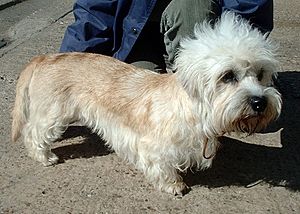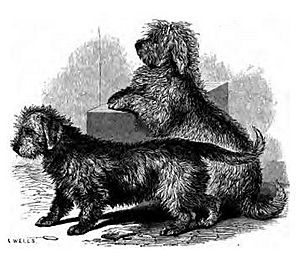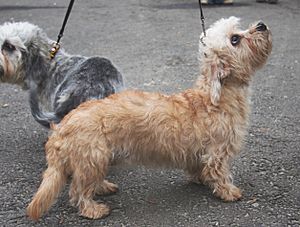Dandie Dinmont Terrier facts for kids

The mustard colour of the Dandie can be any shade including and between reddish brown and fawn.
|
|||||||||||||||||||||||||
| Common nicknames | Dandie Hindlee Terrier |
||||||||||||||||||||||||
|---|---|---|---|---|---|---|---|---|---|---|---|---|---|---|---|---|---|---|---|---|---|---|---|---|---|
| Origin | Scotland | ||||||||||||||||||||||||
|
|||||||||||||||||||||||||
|
|||||||||||||||||||||||||
| Domestic dog (Canis lupus familiaris) | |||||||||||||||||||||||||
The Dandie Dinmont Terrier is a small dog from Scotland. It belongs to the terrier family. This breed has a very long body and short legs. It also has a special "topknot" of hair on its head.
Dandies are known for being friendly but also tough. They usually get along well with older children. These dogs are generally healthy. However, their long bodies can sometimes lead to back problems. They also have a slightly higher chance of getting cancer than some other breeds.
This unique dog breed is named after a character. He appears in a book called Guy Mannering by Sir Walter Scott. The character, Dandie Dinmont, was partly based on a real farmer named James Davidson. He is seen as the person who helped create the modern Dandie Dinmont Terrier.
There are three main clubs in the UK that support the breed. However, the Dandie Dinmont Terrier is listed as a Vulnerable Native Breed. This means not many puppies are registered each year.
Discovering the Dandie Dinmont Terrier
Contents |
Where Did Dandies Come From?
The Dandie Dinmont Terrier comes from the border areas between Scotland and England. People used these dogs in the 1600s to hunt animals. They were especially good at hunting badgers and otters.
No one knows exactly how the breed started. But dogs owned by the Allan family in Holystone, Northumberland were important. This was in the early 1700s. Some people think Dandies might be a type of Border Terrier. Others believe they are a mix of Scottish Terriers and Skye Terriers.
Willie "Piper" Allan was the head of the Allan family. He kept dogs for hunting otters. A rich man, Lord Ravensworth, once hired Allan to clear otters from his pond. Allan did a great job. Lord Ravensworth tried to buy one of Allan's dogs, but Allan refused to sell it.
How the Dandie Got Its Name
The Dandie Dinmont Terrier was not well-known until 1815. That's when Sir Walter Scott's book Guy Mannering was published. Scott had spent time in the border region. He learned how good these terriers were at hunting foxes and otters.
In his book, Scott created a character named Dandie Dinmont. This character owned several terriers. He named them Pepper and Mustard, just like their coat colours. The character Dandie Dinmont was partly based on a real farmer. His name was James Davidson. Davidson also used the names Pepper and Mustard for his dogs.
Davidson kept good records of his dog breeding. Because of this, he is known as the person who started the modern Dandie Dinmont breed. The Dandie Dinmont Terrier is still the only dog breed named after a fictional character!
Breed Clubs and Recognition
In the mid-1800s, some Dandies might have been bred with other dogs. Some people think Dachshunds might have been involved. But many breeders at the time disagreed. By the mid-1800s, the breed was officially called the Dandie Dinmont Terrier. People wanted them for hunting after Scott's book came out.
The Kennel Club was formed in 1873. Soon after, the Dandie Dinmont Terrier Club (DDTC) was created in 1875. This was one of the oldest dog breed clubs in the world. The club helped create the official rules for what a Dandie Dinmont Terrier should look like. This is called the breed standard.
The Dandie Dinmont Terrier was first recognized by the American Kennel Club (AKC) in 1888. It was also recognized by the United Kennel Club (UKC) in 1918.
A Vulnerable Breed
During the Second World War, many dog kennels closed. Dogs were sometimes destroyed because there wasn't enough food or people to care for them. After the war, some kennels worked hard to bring the breed back.
In 2006, the Kennel Club put the Dandie Dinmont Terrier on a special list. It became one of the rarest dog breeds from the British Isles. This list is for "Vulnerable Native Breeds". These are breeds from the UK and Ireland with fewer than 300 puppies registered each year.
For example, between July and September 2003, only 21 Dandie puppies were registered. In the whole year, only 90 were registered in the UK. This is a very small number compared to other popular breeds. For instance, nearly 10,000 West Highland White Terrier puppies were registered that same year!
Since 2006, efforts have helped the numbers improve a little. In 2010, 151 Dandie puppies were registered. This was the highest number in ten years. Still, only a few other native terrier breeds have fewer registrations.
What Does a Dandie Dinmont Terrier Look Like?
Dandies have short legs and a long body. Unlike most Scottish terriers, their ears hang down. Their neck is strong and muscular. This helped them when hunting larger animals.
A typical Dandie stands about 8–11 inches (20–28 cm) tall at the shoulder. They usually weigh between 18–24 pounds (8.2–10.9 kg).
Dandies have a silky coat. This coat forms a special "topknot" on top of their head. The Dandie Dinmont Terrier has a body shape similar to the Skye Terrier. However, the Skye's coat is much thicker and longer.
Coat Colours
The Dandie's coat comes in two main colour groups: pepper and mustard.
- Pepper coats can range from a dark bluish-black to a very light silvery-grey.
- Mustard coats can be reddish-brown to a light fawn colour. Their head might even look almost white.
Usually, their legs and feet are darker. The lighter body colour slowly blends into the darker leg colour. Their coat can be up to 2 inches (5.1 cm) deep. A Dandie's coat colour is usually set by eight months old. But the dog will keep growing and maturing until it's about two years old.
Dandie Dinmont Terrier Personality
Dandies are tough dogs, but they are usually friendly. They are good pets for families with older children. They make both good companions and good guard dogs. They are also among the calmest of the terrier breeds. They don't usually demand a lot of attention from their owners.
However, Dandies are known for being excellent diggers! They can dig big holes very quickly. They can be trained to get along with cats. But you should not trust them around smaller pets like hamsters or rats. They are described as being "very game." This means they are likely to challenge other animals, including foxes, and sometimes even other dogs.
Dandie Dinmont Terrier Health
Because of their long bodies, Dandies can sometimes have back problems. This can involve the intervertebral discs in their spine. These discs can sometimes slip out of place. This can lead to pain or even paralysis in serious cases.
Breed clubs work hard to prevent genetic problems. So, there are no very common health issues for Dandies. However, some minor problems can include hypothyroidism (a thyroid issue) and glaucoma (an eye condition). To help with glaucoma, breed clubs suggest regular eye checks for Dandies. Dandies also have a slightly higher risk of cancer than average.
A Dandie Dinmont Terrier usually lives for about 11 to 13 years.
Images for kids
See also
 In Spanish: Dandie Dinmont terrier para niños
In Spanish: Dandie Dinmont terrier para niños





